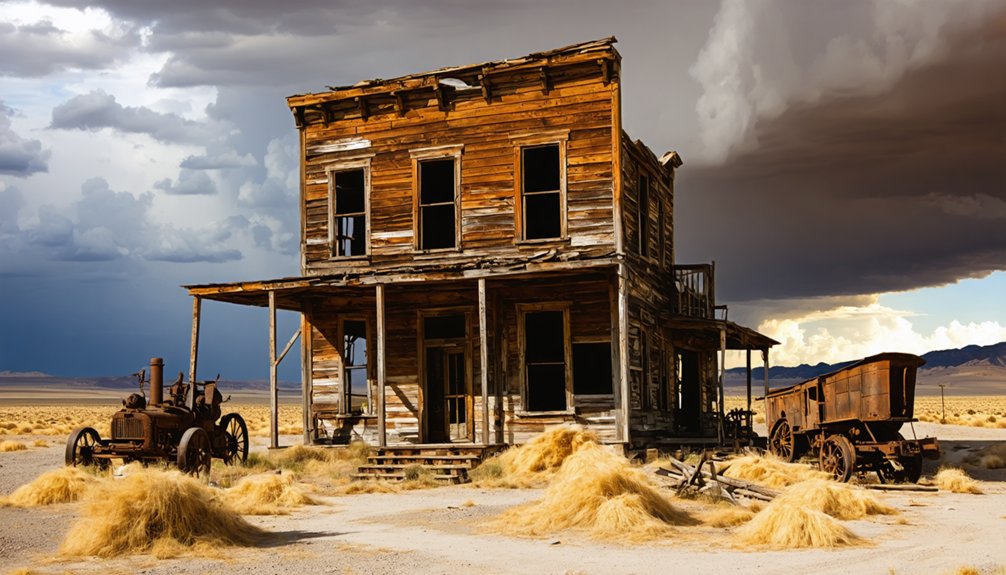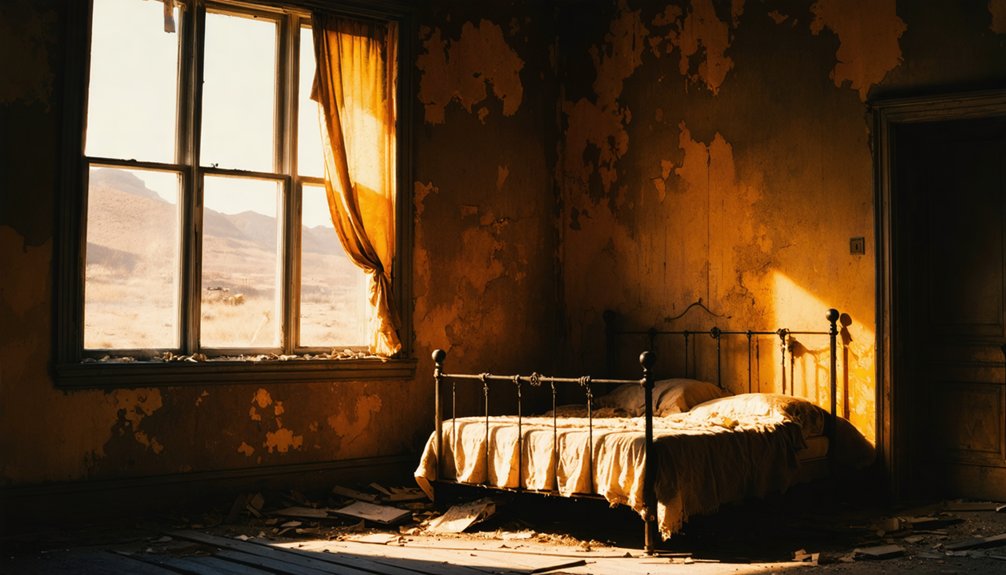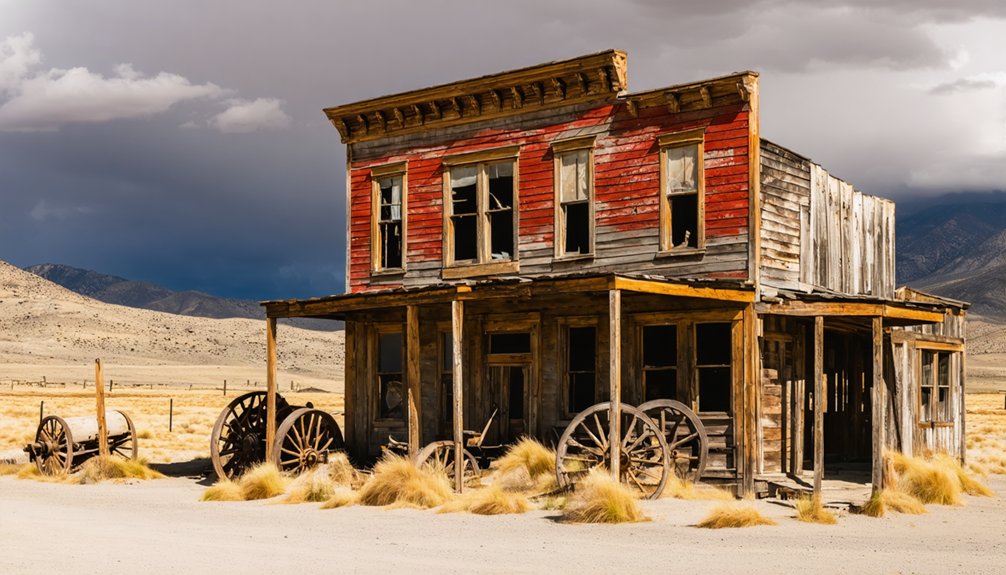America’s most haunted ghost towns include Bodie, California, preserved in “arrested decay” with reports of spirits near Boothill Graveyard; Bannack, Montana, where Sheriff Plummer’s ghost haunts Hotel Meade; and Cahaba, Alabama, known for spectral orbs in flooded ruins. You’ll find St. Elmo, Colorado harbors Annabelle Stark’s wandering spirit, while Ruby, Arizona carries bloody memories of mercantile murders. These abandoned settlements offer more than just history—their supernatural residents await your discovery.
Key Takeaways
- Bodie, California features over 100 preserved buildings with ghostly encounters frequently reported near Boothill Graveyard.
- Bannack, Montana is haunted by Sheriff Plummer’s gang, with Hotel Meade hosting spectral residents including Dorothy Dunn.
- St. Elmo, Colorado houses Annabelle Stark’s wandering spirit and mysterious phenomena like temperature drops and unexplained door slammings.
- Cahaba, Alabama, once a Confederate prison and Alabama’s first capital, features haunted ruins with ghostly orbs and spectral figures.
- Phantom miners carrying lanterns or pickaxes are commonly reported in abandoned mine shafts across ghost towns of the American West.
The Ghostly Tableaux of Bodie, California
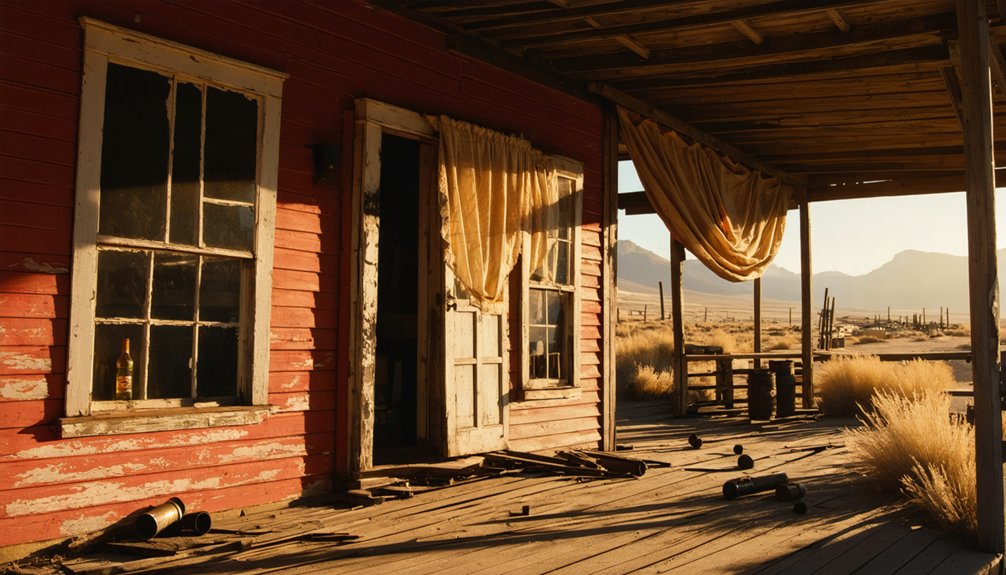
Few ghost towns capture the imagination quite like Bodie, California, a weathered memorial to America’s gold rush era preserved in “arrested decay.”
This Sierra foothills settlement, established after William Bodey’s 1859 gold discovery, harbors a foundation built on tragedy—beginning with its namesake’s death in a blizzard and the subsequent misspelling of his name.
When you walk Bodie’s dusty streets today, you’ll encounter over 100 buildings frozen in time, their interiors still cluttered with abandoned possessions.
The town’s haunted history springs from its notoriously violent past, where 65 saloons once served a population reaching 10,000.
Visitors regularly report ghostly encounters—unexplained sounds, apparitions, and cold spots—particularly near Boothill Graveyard. The name “Bodie” appears in multiple disambiguation resources across reference materials due to its various historical associations.
The eerie tableaux of the Boone Store with its stocked shelves and the hollow Bodie Bank vault intensify the unsettling sensation of being watched. A technological marvel for its time, the town developed an advanced hydro-electric center in 1893 through the Standard Consolidated Mining Company.
Bannack, Montana: Where Outlaws Still Roam
In Bannack’s storied past, you’ll encounter the dark legacy of Sheriff Henry Plummer, who led his notorious “Innocents” gang until vigilante justice claimed his life in 1864.
The original gallows where Plummer and his accomplices met their fate still stands as a grim reminder of frontier justice in this once-thriving gold rush town.
Hotel Meade, once the center of Bannack’s social scene, now hosts spectral residents including Dorothy Dunn, whose blue-dressed apparition is frequently reported by visitors, particularly children who claim to communicate with her spirit. The hotel was originally the county courthouse until Dr. John Meade purchased and remodeled it in 1890. The Chrismans’ Store has become infamous for shadowy figures that many believe are connected to members of Plummer’s gang.
Sheriff Plummer’s Ruthless Gang
Beneath the rugged facade of Bannack, Montana, Sheriff Henry Plummer orchestrated one of the most notorious criminal enterprises in Wild West history while paradoxically serving as the town’s chief law enforcement officer.
Plummer’s reign began after his May 1863 election, when he appointed known criminals as deputies and allegedly led over 100 gang members in systematic gold theft operations.
The Innocents Gang, headquartered at Rattlesnake Ranch, operated twelve miles from Virginia City, Montana, where they coordinated their criminal activities.
The gang targeted the seventy-mile gold transport route between Virginia City and Bannack.
As murders exceeded 100 and gold theft topped 1,000 pounds, citizens formed the Montana Vigilantes on December 23, 1863.
Vigilante justice swiftly followed—by February 1864, they’d executed at least twenty suspected gang members, including Plummer himself, who was hanged on the very gallows he had constructed as sheriff.
The controversy surrounding his guilt persists today, with historians questioning whether evidence justified the summary executions.
Hangman’s Gallows Remains Standing
Standing as a grim reminder of frontier justice, the gallows in Bannack, Montana represents one of the most physically intact symbols of the Wild West’s brutal approach to maintaining order.
Built by Sheriff Henry Plummer in 1863, this wooden structure became the instrument of his own demise when vigilantes hanged him there on January 10, 1864. The gallows history is steeped in irony—Plummer constructed it for executing criminals, never imagining he’d face its noose.
When you visit today, you’re witnessing the actual site where vigilante justice transformed Montana’s territorial landscape.
Before the establishment of proper jails, accused criminals were temporarily restrained without any formal facility in the rapidly growing mining town.
These vigilante actions resulted in the execution of 21 criminals in the weeks following Plummer’s hanging.
Despite Bannack’s eventual decline after losing its capital status to Helena in 1877, the gallows remains preserved among the ghost town‘s weathered buildings. It stands as physical testimony to a chaotic era when frontier communities took law into their own hands.
Hotel Meade’s Ghostly Guests
While the gallows represent Bannack’s frontier justice, Hotel Meade embodies the ghost town’s more refined yet equally haunted past.
Originally built as the Beaverhead County Courthouse in 1875, Dr. John Meade transformed the vacant structure into a luxury hotel around 1890, complete with fine furnishings and imported china.
As you explore the unrestored building, you’ll sense its dual identity as both a social hub and a hotbed of ghostly encounters. The striking diamond pattern railings added during preservation efforts provide a glimpse into the hotel’s historical character. The Italianate architectural style of the building stands as a testament to the town’s former prosperity and ambition.
The spirit of a young girl who drowned in a nearby sludge pond is said to make her presence known, particularly to children.
Two permanently locked doors at the hallway’s end allegedly contain dark entities.
This haunted history reflects the hotel’s fluctuating fortunes, as it operated intermittently until the 1940s before being preserved as part of Montana State Park in 1954.
The Watery Spirits of Cahaba, Alabama
Situated at the confluence of two mighty rivers, Cahaba, Alabama, emerges as perhaps the most water-haunted ghost town in American history.
Cahaba’s history began atop ancient Native American earthworks before becoming Alabama’s first capital in 1819. This promising settlement, once home to 3,000 souls, met its demise through relentless flooding and disease.
The town’s haunted ruins tell stories of profound transformation—from seat of government to Confederate prison site Castle Morgan, then briefly a Reconstruction-era political center for freedmen.
After the devastating 1865 flood, Cahaba surrendered to nature, its buildings dismantled or consumed by flame.
Today, ghostly orbs reportedly float through C.C. Pegues’ garden maze, while spectral figures wander among Crocheron Columns and the Victorian-fenced African American cemetery—watery spirits reclaiming their flooded domain.
Jersey Devil Hauntings in Batsto Village
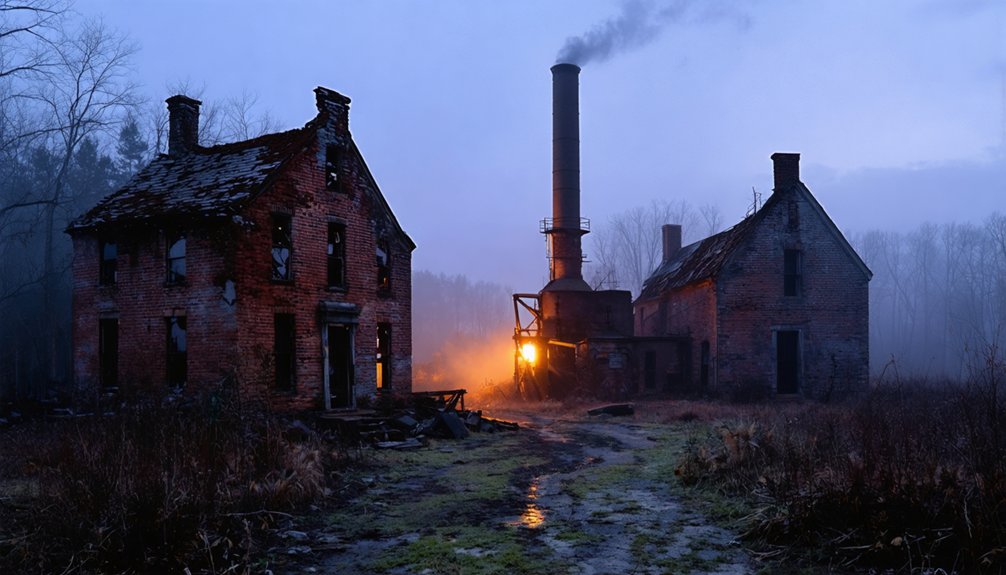
Deep within the haunting expanse of New Jersey’s Pine Barrens, Batsto Village emerges as the epicenter of the region’s most enduring supernatural legend: the Jersey Devil. Established in the 1700s as an industrial community, this historic site’s isolation and dense forests create the perfect backdrop for encounters with the infamous creature.
The Pine Barrens’ abandoned industry gives way to something more primeval—a landscape where legend and reality blur in frightening harmony.
The 1980 Batsto sightings, documented by Chief Forest Ranger Alan MacFarlane, remain among the most credible Jersey Devil reports, describing a bipedal, winged entity emitting blood-curdling screeches.
- Physical evidence includes unexplained tracks in snow and around abandoned buildings
- Witnesses consistently describe a creature with hooves, wings, and a goat-like head
- The village’s haunted reputation attracts paranormal enthusiasts seeking freedom from conventional explanations
The frequency of Jersey Devil sightings has transformed Batsto into a cultural phenomenon and paranormal tourism destination.
Ruby’s Blood-Soaked Mining Legacy
You’ll find Ruby’s violent past centered around its infamous mercantile murders, where two separate double homicides in 1922 and 1931 cemented the town’s dark reputation.
The Montana Mine’s 24-hour operation contributed not only to Arizona’s lead and zinc production but also to supernatural legends following mysterious mining deaths.
These tragedies, combined with the town’s general lawlessness and isolation, have transformed Ruby into what many consider Arizona’s most haunted ghost town, with its abandoned buildings and mine shaft now home to both physical and spectral residents.
Massacre At The Store
The blood-soaked history of Ruby’s mercantile store stands as one of Arizona’s most horrific episodes of frontier violence, marked by two brutal massacades that occurred within a year of each other.
You’ll find the haunted mercantile‘s walls still bear bullet holes from these attacks—permanent scars where Alexander Frazer was gunned down in 1920, followed by the savage murders of John and Irene Pearson in 1921.
The second attack sparked the Southwest’s largest manhunt, eventually leading to the capture of Manuel Martinez and Placidio Silvas.
- Bandits smashed victims’ gold-crowned teeth with gun butts during their merciless assault
- Massacre ghosts are said to linger where perpetrators demanded tobacco before initiating their violence
- The two-story adobe structure remains as a silent witness, accessible only through private land arrangements
Supernatural Mining Deaths
While the mercantile murders established Ruby’s reputation for violence, the town’s mining operations harbored equally sinister stories of death and supernatural phenomena.
The Montana mine, Ruby’s economic heart, extracted wealth at a terrible human cost. Miners faced constant peril from the unforgiving rhyolite rock, temperamental steam-powered crushers, and rockslides triggered by the 1887 earthquake.
You’ll find that supernatural occurrences in Ruby are often traced to these mining tragedies. Over 300 men toiled underground during peak operations, with an unknown number meeting their deaths in poorly documented accidents.
Today, visitors report strange sounds echoing from abandoned mine shafts and glimpses of spectral miners still performing their duties. Unlike the violent mercantile hauntings, these spirits appear benign—perhaps still bound to the earth they labored beneath until their untimely deaths.
Notorious Mercantile Murders
Ruby’s reputation for violence crystallized around the notorious Ruby Mercantile, where two devastating double homicides occurred in rapid succession between 1920 and 1921.
These brutal incidents claimed six lives total, permanently marking Ruby’s historical legacy and contributing to its status as one of Arizona’s bloodiest mining towns.
- The Frazer brothers owned the store just eleven days before Mexican bandits executed them after cutting the only telephone line.
- Frank and Myrtle Pearson met similarly grotesque fates when seven bandits stormed the mercantile, shooting Frank twice in the back and Myrtle in the neck and head.
- The 1921 murders triggered Arizona’s largest manhunt, involving 700 volunteers and the state’s first aerial search.
Ruby’s hauntings now center on the Mercantile legacy, with the abandoned building standing as a silent symbol of the town’s blood-soaked history.
St. Elmo: Abandoned But Never Empty
Nestled in Colorado’s rugged terrain, St. Elmo stands as one of the state’s best-preserved ghost towns, where history and ghostly legends intertwine. Founded in 1880 during the gold rush, this once-thriving community housed 2,000 residents before its decline in the 1920s when mining profits dwindled.
Today, you’ll find remarkably intact structures—hotels, saloons, and the general store—testament to St. Elmo’s rich mining heritage. Though nearly abandoned, approximately ten permanent residents remain, including descendants of the Stark family who maintained the town for decades.
You’re likely to hear tales of Annabelle Stark’s spirit wandering the streets she once called home. Visitors report mysterious temperature drops and doors slamming shut without explanation.
These paranormal claims, centered around original buildings, have transformed this National Historic District into a magnet for those seeking freedom and supernatural encounters.
Phantom Miners of the American West
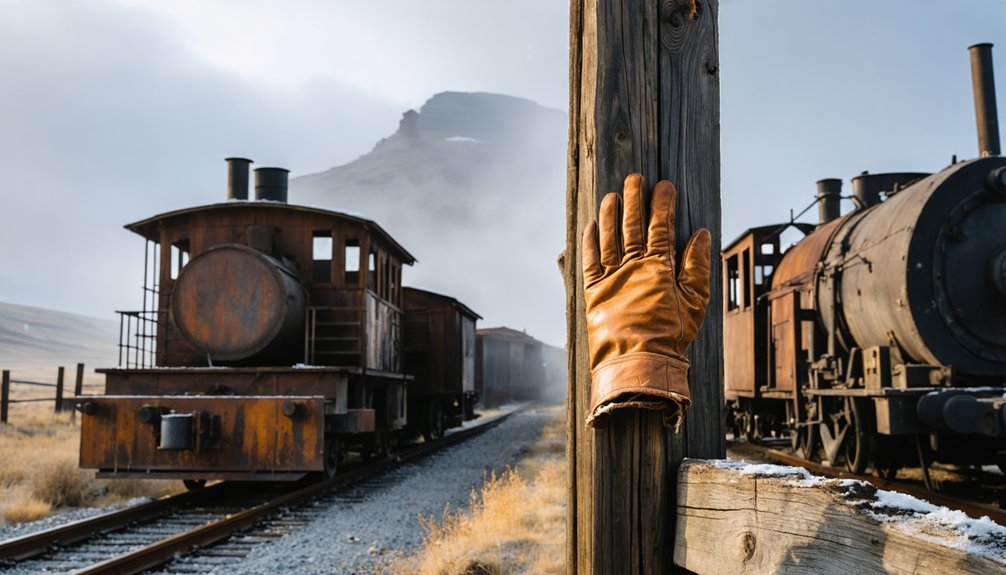
Throughout the forsaken mining towns of the American West, phantom miners represent one of the most prevalent supernatural phenomena reported by visitors and locals alike. These apparitions, often witnessed at dusk carrying lanterns or wielding pickaxes, continue their ghostly labor in abandoned shafts across locations like Bannack, Panamint City, and Ruby. Their spectral presence typically stems from violent deaths, unresolved disputes over claims, or catastrophic mining accidents.
- Shadowy figures emerge with spectral tools near mine entrances in Deadwood, SD, where unexplained sounds of mining activity persist despite decades of abandonment.
- Panamint City’s Crystal Mill area hosts a recurring ghost miner whose pickaxe echoes through the night, perpetuating his eternal work.
- Ruby, AZ manifests apparitions of miners who died tragically, including a smelter worker burned alive, symbolizing the harsh realities faced in these frontier communities.
Unsolved Mysteries and Unexplained Phenomena
Beyond the spectral miners who haunt abandoned shafts, ghost towns across the world harbor deeper enigmas that defy conventional explanation.
Consider Roanoke’s mysterious disappearances, where over 100 settlers vanished in 1590, leaving only the unexplained artifact of “Croatoan” carved into a tree.
You’ll find similar inexplicable phenomena in Varosha, frozen in time since 1974, where visitors report ghostly encounters and inexplicable cold spots throughout the abandoned city.
Belchite’s war-torn ruins echo with disembodied voices and phantom battle sounds, while North Carolina’s Road to Nowhere abruptly terminates at a tunnel, its purpose lost to history.
Even Covewood Lodge harbors reports of moving objects and spectral apparitions.
These locations challenge our understanding of reality, suggesting that some mysteries may forever remain beyond our comprehension.
How to Capture Evidence of the Paranormal on Your Ghost Town Visit
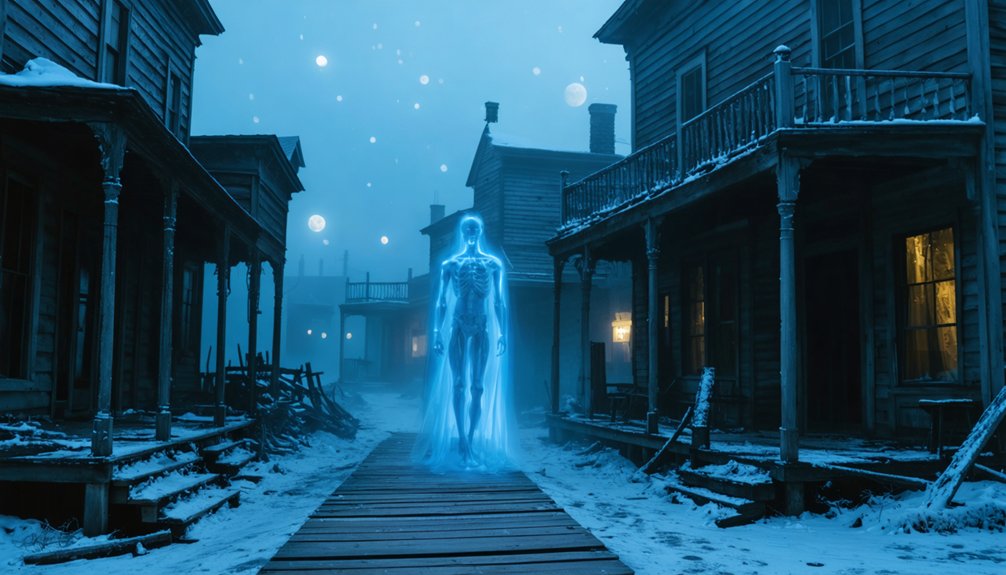
When exploring abandoned ghost towns in search of paranormal activity, your ability to document credible evidence depends considerably on proper equipment and methodical investigation techniques.
Start by establishing baseline EMF and temperature readings before conducting your investigation. For best results, combine technology with systematic documentation methods. Your paranormal equipment should include EMF detectors to identify readings between 2.0-7.0 that may indicate spirit presence, and audio recorders for capturing EVPs undetectable to the human ear.
Establish EMF and temperature baselines before investigating with proper equipment to capture anomalies beyond normal human perception.
- Use flashlight communication by slightly loosening the twist mechanism, allowing potential entities to manipulate the connection.
- Deploy trigger objects strategically throughout the location to encourage interaction and document any movement.
- Conduct both passive observation sessions and direct questioning periods to maximize your ghost hunting techniques’ effectiveness.
The Psychology Behind Ghost Town Hauntings
You’ll notice how ghost towns serve as perfect projection screens for your subconscious fears and unresolved emotions, often manifesting as perceived hauntings when confronted with derelict buildings and abandoned spaces.
This psychological phenomenon isn’t merely coincidental but represents a natural human tendency to process complex feelings through external manifestations, particularly in environments that already carry heavy emotional resonance.
Your belief in ghost town hauntings also functions as a preservation mechanism, keeping the memory and significance of these historical sites alive through supernatural narratives that compel continued visitation and cultural attention.
Projecting Our Fears
While ghost town hauntings captivate our imagination and provoke visceral fear responses, they primarily reflect deeply ingrained psychological phenomena rather than supernatural occurrences. Your brain naturally seeks agency in random events—attributing creaking floorboards to spirits rather than temperature changes exemplifies this cognitive bias. This fear manifestation transforms ordinary stimuli into perceived paranormal activity when primed by contextual suggestions.
Your heightened sensory awareness in atmospheric settings creates perfect conditions for misinterpreting shadows or sounds.
Environmental factors like mold exposure or carbon monoxide can induce hallucinations mistaken for ghostly encounters.
Cultural projection shapes your interpretation of ambiguous stimuli based on local legends and personal beliefs.
These psychological mechanisms explain why you’re more likely to “experience” hauntings in places you’ve been told are haunted, especially when emotional arousal impairs your perceptual accuracy.
Preservation Through Belief
Belief in the paranormal extends far beyond mere entertainment value—it functions as a critical preservation mechanism for abandoned settlements across the country.
When you encounter a “haunted” ghost town, you’re witnessing how supernatural narratives create financial sustainability through paranormal tourism. These ghostly reputations generate revenue that directly funds historical preservation efforts for deteriorating structures that might otherwise collapse into obscurity.
Communities strategically leverage these spectral stories, transforming forgotten places into cultural assets worthy of protection. The psychological investment created by haunting narratives fosters deeper connections to local history and strengthens community identity.
Media amplification of these supernatural tales expands awareness, attracting preservation advocates and researchers. By maintaining oral traditions of paranormal activity, local consciousness guarantees these sites remain relevant in contemporary culture, preserving not just buildings but the emotional resonance of our collective past.
Frequently Asked Questions
Are Children Allowed on Nighttime Ghost Tours?
Yes, children can join nighttime ghost tours, but you’ll find most operators enforce child age restrictions and ghost tour guidelines requiring adult supervision for participants under 16.
What’s the Best Season to Experience Paranormal Activity?
Autumn offers ideal paranormal conditions with its fall ambiance of longer nights and atmospheric conditions, though some phenomena intensify during the summer solstice when cosmic energies peak. You’ll encounter maximum activity October-November.
Can Visitors Bring Electromagnetic Field (EMF) Detectors?
You can typically bring EMF detectors to haunted locations, though proper ghost hunting etiquette requires checking site-specific regulations first. Many ghost towns permit personal equipment but may enforce usage restrictions.
Do Any Towns Offer Paranormal Investigation Lodging Packages?
Yes, several destinations offer paranormal getaway packages. You’ll find ghost town accommodations at locations like The Mizpah Hotel and The Kern Lodge, which systematically integrate lodging with structured paranormal investigation opportunities.
Have Indigenous Spirits Been Documented in These Locations?
Truth is stranger than fiction. You’ll find limited documentation of indigenous spirit sightings in these locations, as most ghost town lore centers on settler narratives rather than acknowledging indigenous supernatural presence.
References
- https://www.visittheusa.com/experience/5-us-ghost-towns-you-must-see
- https://www.mythfolks.com/haunted-us-ghost-towns
- https://www.realgirlreview.com/dark-tourism-in-america/
- https://www.youtube.com/watch?v=xg8SpCG-wDg
- https://www.geotab.com/ghost-towns/
- https://en.wikipedia.org/wiki/Lists_of_ghost_towns_in_the_United_States
- https://www.atlasobscura.com/lists/americas-best-preserved-ghost-towns
- https://thelittlehouseofhorrors.com/bodie-the-cursed-ghost-town/
- https://en.wikipedia.org/wiki/Bodie
- https://www.youtube.com/watch?v=2Foz-2R_mH8
